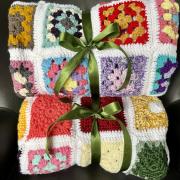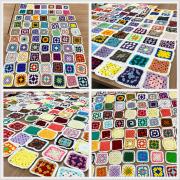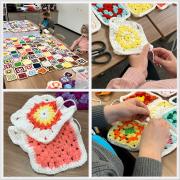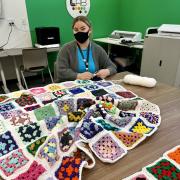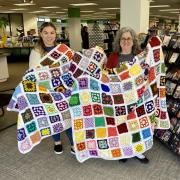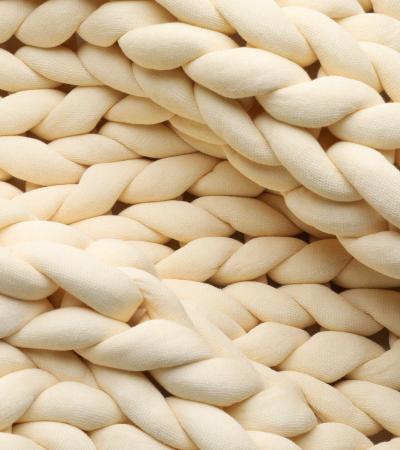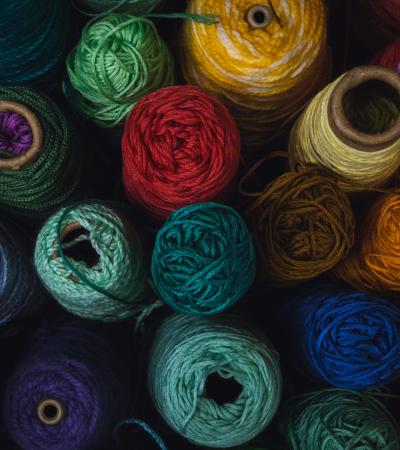The program was inspired to bring the community together with a creative project. Programmers Rachel Babiak and Diana Koepp teamed up to teach a valuable skill and fun pastime. We created two granny square blankets by teaching folks to crochet and by reaching out to our community for donations of granny squares.
We held small classes (up to five patrons each class) teaching attendees how to make basic granny squares. We held six Crochet a Granny Square Classes with 31 people attending the classes. The completed blankets were raffled to those who contributed. We then accepted granny square donations and drew the winners on April 1, 2024.
Advanced Planning
Our main goal for this program was to bring the community together while learning a new skill. We wanted folks to learn how to crochet a basic granny square. We thought the chance to win a blanket that they participated in making would be a great incentive. We began planning about six months before the program began.
We had to see if it was feasible for someone who hadn’t crocheted before to create a granny square in an hour and a half long class. Rachel knew how to crochet so she learned a basic granny square pattern, then taught Diana how to crochet. We decided it would work!
Our biggest challenge in the planning phase was calculating how much yarn would be needed for the project. We ended up not buying enough of the white yarn used to put the blankets together. This was because more squares were donated than we anticipated, so we were able to make two blankets. It was a wonderful, unexpected challenge. Since we had never taught this class before, nor had we ever asked the community for granny square donations, we had no idea how many squares we would receive.
Marketing
Our event was promoted through several outlets: the library website, our quarterly print newsletter, email blasts, Instagram, Facebook, and in-house fliers. We pushed promotion three months before the start of the event and filled each crochet class quickly. We ended up adding two more classes and still had waiting lists. To continue interest in the project, we posted pictures from our classes and highlighted some of the squares that were donated on social media. This showed the great work that had been done and inspired people to donate more. We were very happy with the interest shown.
We were very successful. We had six full crochet classes with waitlists for each class. We received 212 granny square donations from 38 different people and were able to make two blankets. Each blanket used 99 squares. After the blankets were completed, we posted pictures of the winners along with the steps for turning the squares into blankets and fun shots of the beautiful afghans. We were very surprised that our Facebook post regarding the winners and completed blankets was our most liked ever! We got over 750 likes. This has become our most popular Facebook post from the library to date. Who knew?
Budgeting
9 skeins of white yarn = $36.09
10 pack of money pouches = $34.99
10 pack x 2 of crochet hooks size H = $35.98
Total = $107.06
We wanted to be able to circulate the crochet hooks so folks were able to work at home. We purchased 10 hooks for circulation and 10 hooks for in-house use. We also purchased “money” pouches to keep the circulating hooks in. The hooks and pouches were the bulk of the money spent. We only spent $36.09 on yarn. Total cost including yarn, pouches, and hooks was $107.06.
We were able to keep some of the costs down by using yarn that was donated at our Craft Swap event. It was nice to offer a variety of colors of yarn for our classes that way. We checked the donated yarn for suitability. We also purchased some plain white yarn in bulk for a less expensive price than individual skeins. The plain white yarn was used for bordering all the squares and then connecting the blanket. Ultimately, this was a pretty low-cost program.
Day-of-event Activity
For each class, we utilized our maker space with the projector and whiteboard. Folks could follow along as each step was demonstrated. We provided a paper pattern diagram and step-by-step instructions that were helpful for different learning styles. We also sent follow-up emails after every class with a link to a YouTube video utilizing the same pattern we taught in the classes. This helped new crocheters remember the steps.
We used two staff members throughout the project. Rachel instructed and demonstrated while Diana troubleshooted and helped one-on-one as needed. Both crocheted borders, arranged squares, wove in ends and attached the squares to make the blanket(s). It was truly a team effort.
One challenge we faced was differing levels of ability in each class. We also found that receiving squares made by different people meant a great deal of variation in stitch size and suitability. We had advertised that the winner(s) would be drawn on April 1, 2024. Since we received double the number of squares anticipated, we had to change the date for winners to pick up their blankets to give ourselves time to finish making them.
Program Execution
The classes were very successful. We hosted six classes with up to five patrons in each class. Rachel led the program, utilizing an overhead camera, showing the stitches and pattern on a screen while Diana walked around and helped as needed. We had 31 people come to classes. At the classes, participants received one raffle ticket for attending and a second raffle ticket if they donated the square they made. Class attendees could choose to keep or donate squares.
We asked for 5x5 squares in any pattern or color. Patrons could donate as many as they wanted and receive one raffle ticket per square to win the finished blankets. Once we received enough squares to make a blanket, Rachel and Diana started laying them out and piecing them together. We had 212 squares donated by 38 different people.
There was a lot of positive feedback. Most attendees said that they really enjoyed the program. Those that never crocheted before said that they had wanted to learn and enjoyed the process. We exceeded our goals. Participation was double what we had even hoped for. It went so well that we are already brainstorming ideas to do this again next year.
Advice
Have at least two staff members to teach crochet for each class and keep the classes small, at 4 - 6 participants. Also, you’ll need to consider your turnaround time for bordering squares and putting the blanket together. Again, at least two staff members are recommended to complete the blankets.
We also do not recommend using any yarn that is too fine or too thick. For all our classes we used light and medium worsted weight yarn. We also used size H (5.mm) crochet hooks. Of course, folks used what they had at home, but we found that when the hook size and yarn were all within the same thickness the blanket was more cohesive.
Depending on your community size, consider limiting the number of raffle tickets and/or squares per person. We had one person donate 40 squares.
Give yourself enough time to finish the blanket(s) before announcing the winners. We had originally only given ourselves one week between the end of collecting squares and when the winners were drawn. We were able to complete it in time but it added stress!

